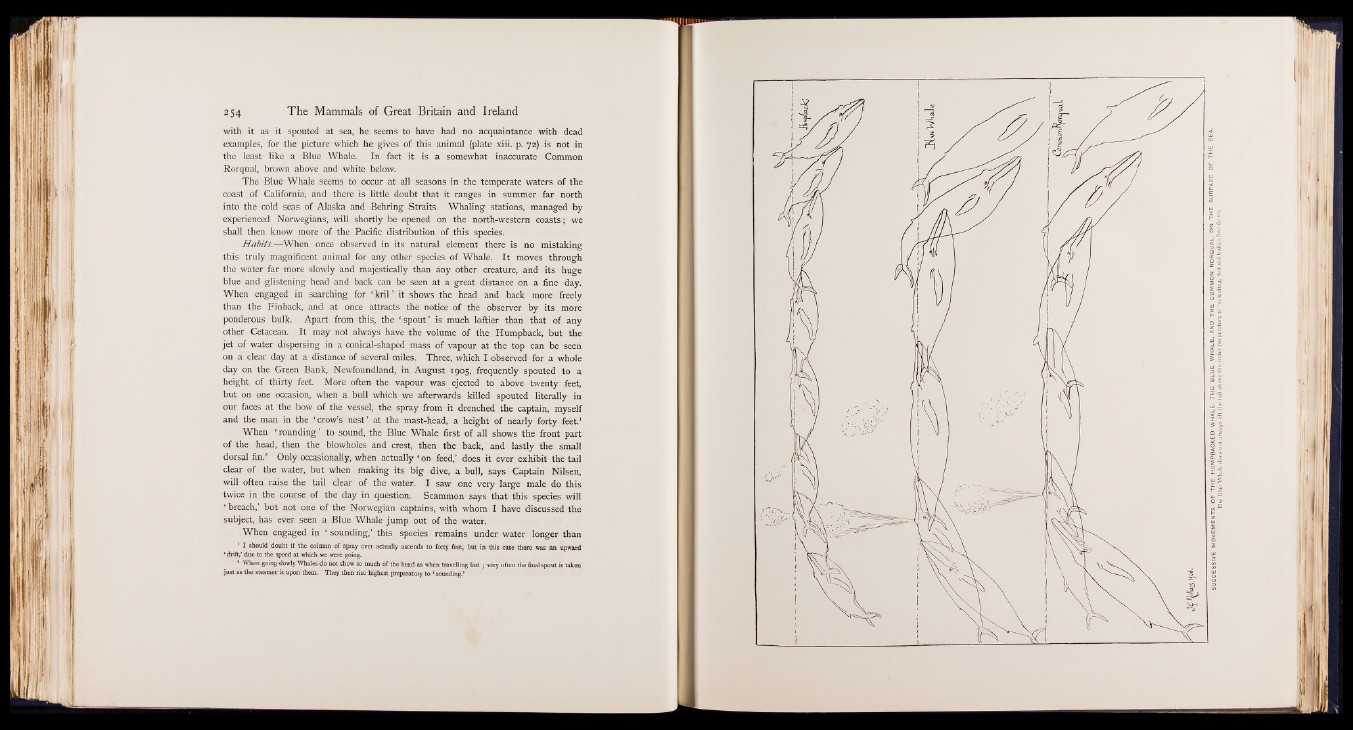
with it as it spouted at sea, he seems to have had no acquaintance with dead
examples, for the picture which he gives of this animal (plate xiii. p. 72) is not in
the least like a Blue Whale. In fact it is a somewhat inaccurate Common
Rorqual, brown above and white below.
The Blue Whale seems to occur at all seasons in the temperate waters of the
coast of California, and there is little doubt that it ranges in summer far north
into the cold seas of Alaska and Behring Straits. Whaling stations, managed by
experienced Norwegians, will shortly be opened on the north-western coasts; we
shall then know more of the Pacific distribution of this species.
H abits.—When once observed in its natural element there is no mistaking
this truly magnificent animal for any other species of Whale. It moves through
the water far more slowly and majestically than any other creature, and its huge
blue and glistening head and back can be seen at a great distance on a fine day.
When engaged in searching for ‘ kril ’ it shows the head and back more freely
than the Finback, and at once attracts the notice of the observer by its more
ponderous bulk. Apart from this, the ‘ spout’ is much loftier than that of any
other Cetacean. It may not always have the volume of the Humpback, but the
jet of water dispersing in a conical-shaped mass of vapour at the top can be seen
on a clear day at a distance of several miles. Three, which I observed for a whole
day on the Green Bank, Newfoundland, in August 1905, frequently spouted to a
height of thirty feet. More often the vapour was ejected to above twenty feet,
but on one occasion, when a bull which we afterwards killed spouted literally in
our faces at the bow of the vessel, the spray from it drenched the captain, myself
and the man in the ‘ crow’s nest’ at the mast-head, a height of nearly forty feet.1
When ‘ rounding ’ to sound, the Blue Whale first of all shows the front part
of the head, then the blowholes and crest, then the back, and lastly the small
dorsal fin.2 Only occasionally, when actually ‘ on feed,’ does it ever exhibit the tail
clear of the water, but when making its big dive, a bull, says Captain Nilsen,
will often raise the tail clear of the water. I saw one very large male do this
twice in the course of the day in question. Scammon says that this species will
‘ breach,’ but not one of the Norwegian captains, with whom I have discussed the
subject, has ever seen a Blue Whale jump out of the water.
When engaged in ‘ sounding,’ this species remains under water longer than
1 I should doubt if the column of spray ever actually ascends to forty feet, but in this case there was an upward
‘ drift,’ due to the speed at which we were going.
* When going slowly Whales do not show so much of the head as when travelling fast; very often the final spout is taken
just as the steamer is upon them. They then rise highest preparatory to ‘ sounding.’